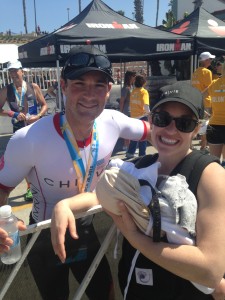Pre-Race: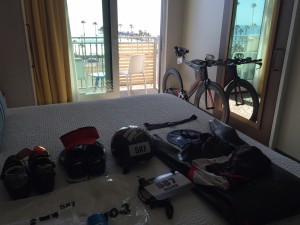
Leading up to Oceanside, I didn’t really know how well I was going to do. I didn’t have a good sense if I had improved in overall fitness over last year at this time. Looking at my numbers and training metrics, it almost seemed like I was less fit this year than the previous year. I had some good training days, but my overall volume was still much lower than some of my friends training for the same race. I also had some health challenges (allergies and infections) and other commitments (new baby) over the winter which didn’t help my overall confidence leading into the spring. Overall, I was feeling good and happy and didn’t feel like I needed to put pressure on myself to perform. I feel that just enjoying the journey and the process can be greatly rewarding in itself.
This race was going to have a different dynamic for me because I was going to be making the trip to Oceanside solo, without any family. Good or bad, I was still looking forward to an enjoyable trip, with plenty of stops along the drive down in SLO and Santa Barbara for family and good food. Even without family around, I still felt pretty busy the Friday before the race, checking in to the hotel, doing the athlete pickup, walking the expo, checking in my bike to transition and going on a short 30 min run to get my legs moving.
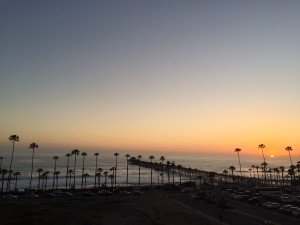
Race Morning:
Race morning I was up at 4:50am. I actually got decent sleep, going to bed around 8:45 and sleeping pretty good. I love hotels where you can turn down the thermostat enough to make the room really cool at night. I had taken a big risk by not grocery shopping the day before for my race morning breakfast. 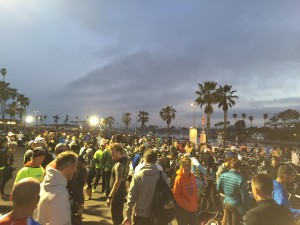 The hotel said they were going to do an early “breakfast” for athletes at 5am, but no one seemed to be able to tell me what they would have ahead of time. One person told me “just coffee” and someone else said “only coffee and oatmeal”. I feel that recently, I’ve been less concerned and picky about my pre-workout fuel. A lot of my workouts are even fasted if they are done early enough in the morning. That, and I was too lazy to go to the store the night before. So I just hoped they had something decent. Since it sounded like there would be 100% chance of coffee at the least, I figured I’d be fine. I could go for 4.5 hours on coffee alone. The breakfast ended up being really decent (for a hotel). Lots of fruit, bagels, pastries, oatmeal, etc. I pretty much tried a little of everything until I was full. Normally, I’m pretty picky with ingredients and food quality, but I was just happy they had options.
The hotel said they were going to do an early “breakfast” for athletes at 5am, but no one seemed to be able to tell me what they would have ahead of time. One person told me “just coffee” and someone else said “only coffee and oatmeal”. I feel that recently, I’ve been less concerned and picky about my pre-workout fuel. A lot of my workouts are even fasted if they are done early enough in the morning. That, and I was too lazy to go to the store the night before. So I just hoped they had something decent. Since it sounded like there would be 100% chance of coffee at the least, I figured I’d be fine. I could go for 4.5 hours on coffee alone. The breakfast ended up being really decent (for a hotel). Lots of fruit, bagels, pastries, oatmeal, etc. I pretty much tried a little of everything until I was full. Normally, I’m pretty picky with ingredients and food quality, but I was just happy they had options.
After breakfast, I went back up to the room, got dressed and then made the 1.2 mile walk from the hotel to the harbor. Setting up transition was pretty uneventful. Since my bike was already there, I just had to lay everything out. I didn’t even add air to my tires. I figure, the less things I had to do and the more I could just relax the better. I feel I always do better when I’m relaxed and the typical tension in the air in transition usually just makes me anxious. I was able to catch up with some friends and take my time getting into my wetsuit. I finally made it to the start shoot and we made our way to the boat ramp, waiting for our wave start.
Swim:
I was surprised how warm the water was, as we made our way from the boat ramp to the in-water start line. I had heard some people complaining about how cold the water was going to be (62F). I guess, with the only ocean swimming I usually do being in the cold Monterey Bay, everything else feels warm. I took a spot on the far side of the buoy line, hoping to avoid some congestion and risk having to take a longer line.
When the horn went off, I put in a solid effort to sprint ahead of the main group. I ended up with about a handful of people from my wave after the first couple hundred yards and then settled into a more sustainable pace. I tried to pace the swim more on the aggressive side. I felt like I was swimming at an effort between “solid” and “kinda hard”. I just kept telling myself, “don’t swallow any water”. Who knows what’s in harbor water. I just didn’t want it in my stomach.
About half way to the turn, the few people I was swimming with started hitting the back end of the wave in front of us. I tried my best to avoid running into the back of someone, but it required me to do a lot more sighting, which just wastes energy. Around the turn around point, the chop started getting pretty rough and I was getting tossed around a lot. As we turned to head back in to the harbor, the sun was directly in my eyes and I lost sight of everything. I couldn’t see a thing with the sun. The best I could do was keep swimming and hope I was going to right way. I just got glimpses of people around me to somewhat guide where I was going. The way back in to the harbor also got pretty crowded. There was a good mix of lots of waves by then, and it was much harder avoiding people.
I finally made it back to the boat ramp and started the LONG run around transition and back to my bike.
Swim Time: 29:24
Bike:
The beginning of the bike leg is always a bit awkward. There are just lots of people doing lots of things. It’s kind of just a mess. It took a few miles to really start settling into things. I tried to keep a strong pace right off the start. My goal was to hit about 240 watts Normalized Power for the ride. I did this a couple weeks before and still felt good at that power for 2.5 hours, so I knew it was very doable with some effort and sweat.
I like the Oceanside bike course because it seems like there is always something different to look at and that keeps your mind busy and away from thinking about the burning in yours legs. This year, I felt like there was less congestion on the course, especially during the first half. There was some initial congestion, but once I got on the base, I didn’t feel like I was around the same people very long. Some races, it feels like you play leapfrog with the same handful of people the whole time, and I didn’t get that this race.
There are some good climbs on the course that forced me to stand in the granny gear, but I actually really like that about Oceanside. Mixing it up and changing positions and muscles is always welcome. What’s also good about a bit of climbing is the downhills. The Dimond bike just kills it on the downhills. I can easily coast in an aero position on the downhills and pass a few people who are still pedaling hard. I love it.
I feel like the bike leg wasn’t eventful, but in a good way. I didn’t get frustrated at people leapfrogging the whole race, I didn’t see packs of people forming, overall it was great. The pace was just at that point where I had to concentrate on pushing hard and couldn’t just let my mind wonder. I think I was pretty consistent at 240 watts most of the ride.
For nutrition, I tried to do 200 calories an hour from UCAN. This is actually more than I usually take on any training ride less than 4 hours. So I knew I was going to have to force it down a bit. I ended the ride with still a fifth of the bottle left, so I ended up with just about 170 calories an hour. A bit light, but it didn’t affect me at all. I figured I could always just prop myself up on coke during the run if needed.
For hydration, I think I could do a little bit better next time. I started with a BTA bottle of Skratch Hyper Hydration just to immediately load with sodium. Then I tried to drink somewhat to thirst, or a bit ahead of thirst. I didn’t really count the bottles, but I filled up every aid station, so I probably did about 96 fl oz of water over the 2.5 hours on the bike.
Bike Time: 2:29:07
NP/AP: 242/235 watts
Run:
I got off the bike and still felt like I had good energy. I know a lot can change when you run. Running is just so hard on the body that a lot can happen in a short time. I had originally planned on starting off with a 7 min/mile pace and holding that. My real goal was to run 6:50 pace because I knew this was doable off the bike. I mentally envisioned this as a short run (just because it’s not the full marathon like in an Ironman). I figure, even worse case and I really fall apart, I can fake it for almost 13 miles. I could, at least, fake it for 10 miles and then just do what it takes to do the last 3 miles.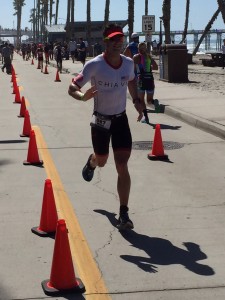
What I like to do off the bike, is just run at a conservative pace for the first few minutes before checking my pace. Then, after a few minutes, check my pace and see what I’m doing. That usually is a good indicator of how I’m feeling and how the race is going to play out. After a few minutes of running, what I thought to be strong but conservative pace, I looked and saw I was running 6:45 pace. I was pretty happy with that and decided to slow down just a hair to be safe.
The run at Oceanside is just so much fun. Because it’s two out and back loops, it really breaks up the run into very small and manageable chunks. Plus, the run along The Strand is just awesome. Can’t beat running along the ocean with a huge crowd. I stuck with my cooling and hydration strategy from Kona where at every aid station I dumped water on my head and back and drank a cup of coke (actually, they used generic “cola” which sucked. I usually don’t drink coke, but if I do, I want the real thing).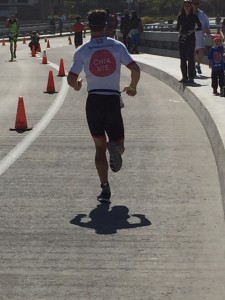
What was truly amazing about the first lap, is that it was really really empty. I mean, there was no one on the course. I got to see all the pros go by, which was incredible. They run so fast, it’s just insane.
I kept drinking “coke” every aid station, knowing I didn’t fuel too well on the bike, so I thought the simple sugar would keep me going. On the second lap, I was still going strong but getting a bit tired. The course started to get pretty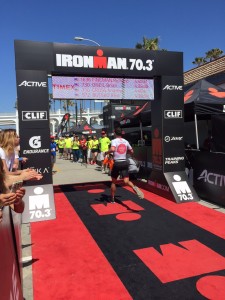 crowded and I had to dodge people the entire second lap. I finally hit mile 10, just before the last turn around. I knew I could run 3 miles in my sleep. There have been so many hard training runs where I have ran the last 3 miles just destroyed. So I know I can run 3 miles on fumes. But I was still feeling pretty good. I picked it up a hair the last couple miles. Well, my pace probably didn’t pick up too much, but my heart rate sure did.
crowded and I had to dodge people the entire second lap. I finally hit mile 10, just before the last turn around. I knew I could run 3 miles in my sleep. There have been so many hard training runs where I have ran the last 3 miles just destroyed. So I know I can run 3 miles on fumes. But I was still feeling pretty good. I picked it up a hair the last couple miles. Well, my pace probably didn’t pick up too much, but my heart rate sure did.
Oceanside finish is one of the best finishes outside of Kona I have done. Just an amazing crowd and a great view.
Time: 1:28:34
Pace: 6:45/mile
Thoughts:
There was no rest after the race. I didn’t even stop to get food, but actually ran (yes ran) to my hotel so that I could get my bags out of the room before my late checkout time. That was pretty painful. At least a got a quick shower in before finally going back to the finish and to the athlete food area. I was the only athlete in the post-race food area already showered and dressed.
I feel like Oceanside was perfectly executed. I was able to pace slightly better than my aggressive goals. This was really the first race where I didn’t do a lot of pre-race planning for pacing, hydration or nutrition. I kind of just let things go and hoped for the best and that seemed to pay off. I’m not sure I can get away with that for a full Ironman though, so I may have to go back to better planning for an IM race later in the year. I think I can fake my way through a 4.5 hour workout, but not through a full day in an Ironman.
One bad thing about having a well-executed race, is not knowing where to go from here. I don’t see much low hanging fruit for future improvement. Sure, I can keep working on aerobic fitness, but I’m not sure I’ll ever be as good as the top guys in a 70.3 race. There are a few lifestyle tweaks I can make and hope for some gain there, but I’m not sure there is too much to be had on that front. At some point you hit a point of diminishing returns for the effort and sacrifice needed for marginal gains in fitness. I guess one area where I can gain some big time in a race is transitions. At Oceanside, my T1 time was almost 5 minutes. I feel like I some mornings I have breakfast and coffee faster than that. I feel like I’m going fast in transition, but obviously there can be a lot of improvement there. Maybe a few minutes can be had between both transitions.
I would really like to do Oceanside again next year, so we’ll see what happens with scheduling. It’s a great race and the energy is one of the best of any races I have done. There is a reason all the fast people show up for this race, it’s just an amazing experience.

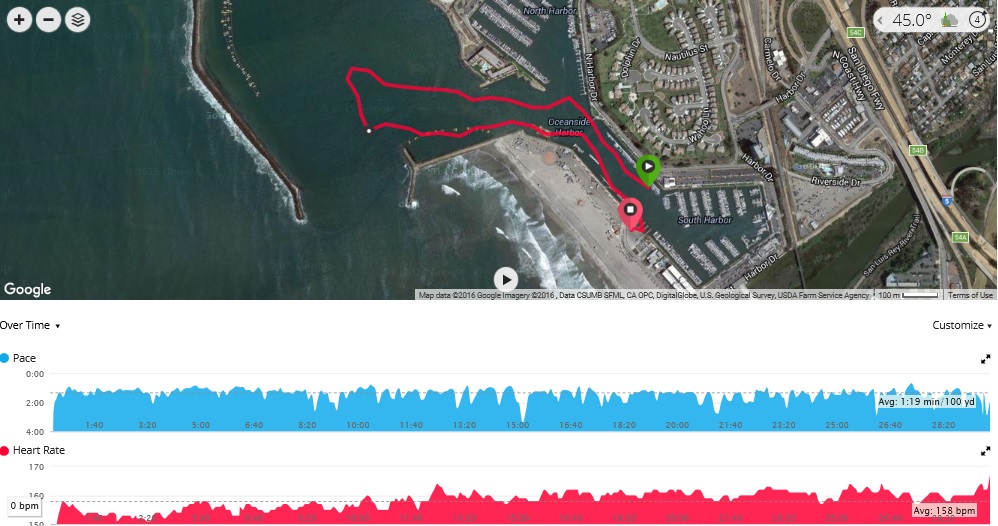
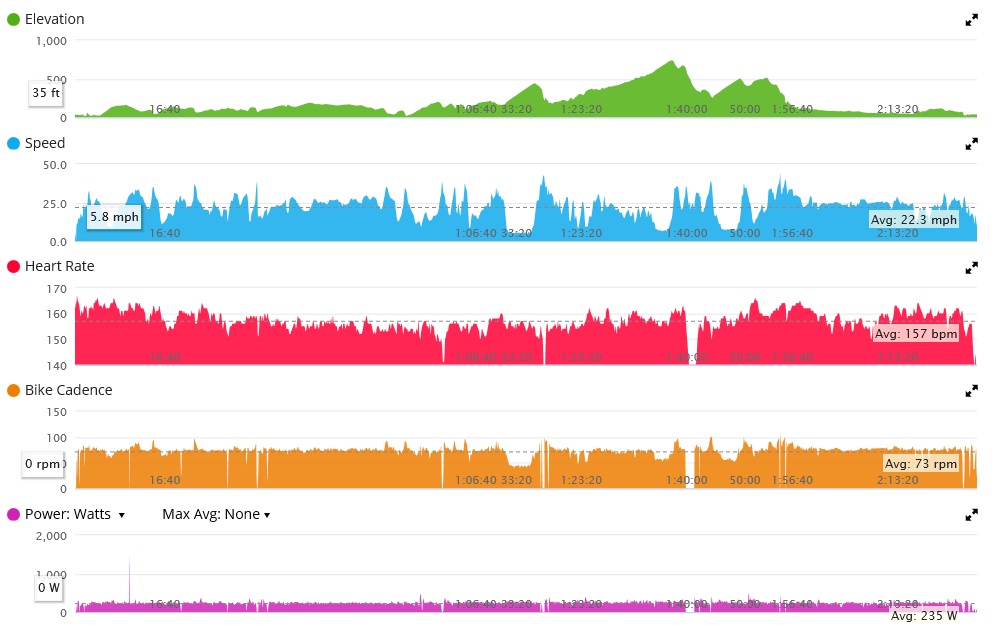
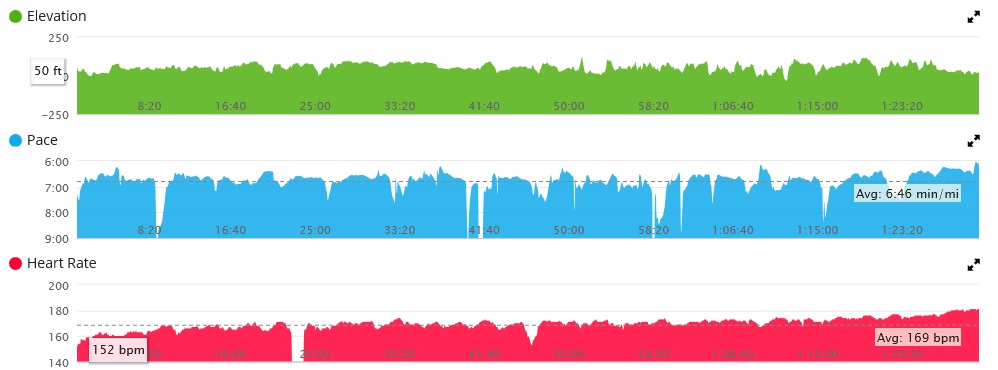
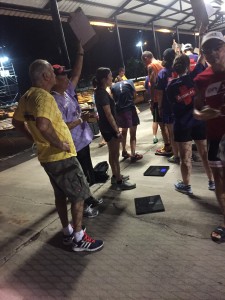 That made me a bit worried about the hot day ahead. I weighed in at 172 lbs!! That’s 12 pounds more than I weighed when I left for Kona. I’m either carrying a lot of water or I’ve had one too many iced mochas. At least I’d kill it on the downhills.
That made me a bit worried about the hot day ahead. I weighed in at 172 lbs!! That’s 12 pounds more than I weighed when I left for Kona. I’m either carrying a lot of water or I’ve had one too many iced mochas. At least I’d kill it on the downhills.
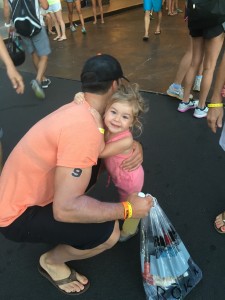

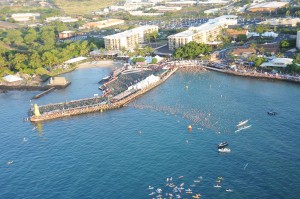
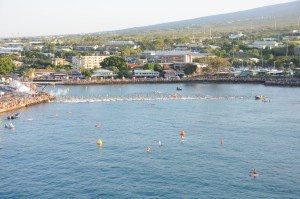



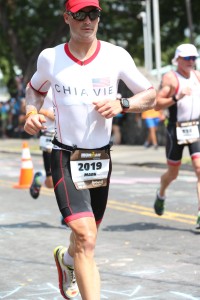
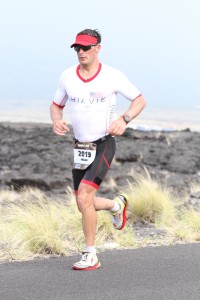
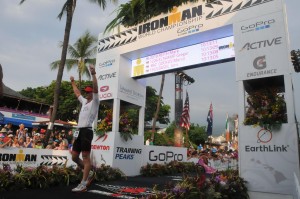

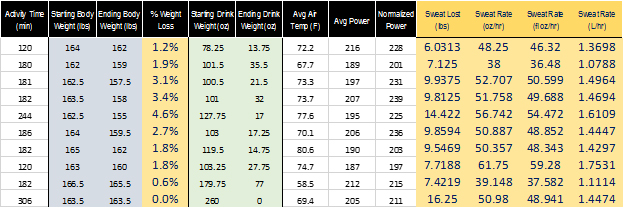
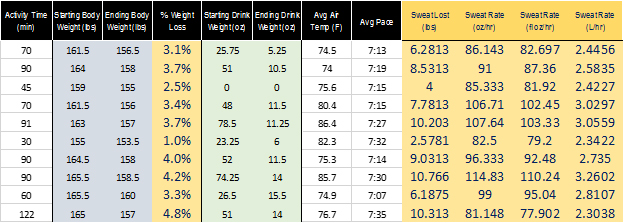
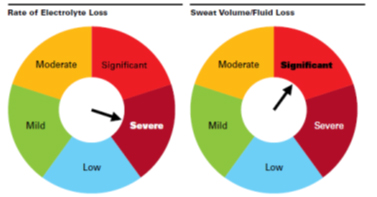
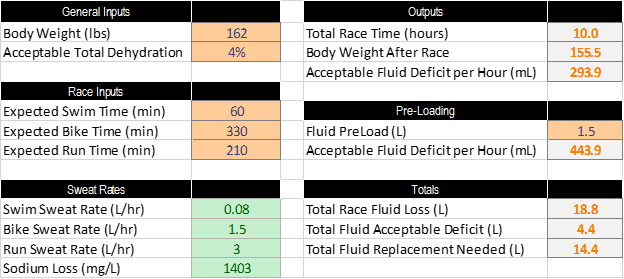
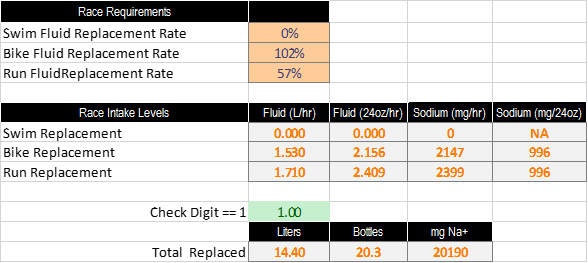

 What was nice about this trip is I didn’t bring any wheels with me. I brought only my bike, which saved me an extra checked bag. I used my Ruster Sports Hen House with their new carat case to pack up my Dimond bike (super easy by the way) and just put my rented wheels on when I got to Whistler.
What was nice about this trip is I didn’t bring any wheels with me. I brought only my bike, which saved me an extra checked bag. I used my Ruster Sports Hen House with their new carat case to pack up my Dimond bike (super easy by the way) and just put my rented wheels on when I got to Whistler.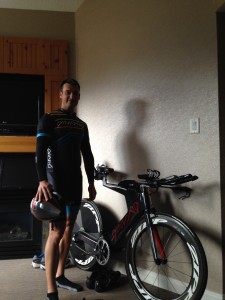 I decided to take my bike out on the road for a quick ride and make sure everything was in working order. The weather report called for scattered showers throughout the day and I wanted to get out before more rain came in.
I decided to take my bike out on the road for a quick ride and make sure everything was in working order. The weather report called for scattered showers throughout the day and I wanted to get out before more rain came in. 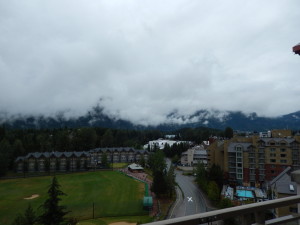 On my ride, the roads were pretty wet, but at least it wasn’t raining (I hate riding in the rain). I rode 15 minutes on the highway toward Pemberton and then back. The roads, aside from the puddles, were in great condition, and I was looking forward to having the whole lane for the race instead of just the shoulder. I spent the rest of the day, relaxing with the family and enjoying the area by doing the Peak2Peak gondola ride.
On my ride, the roads were pretty wet, but at least it wasn’t raining (I hate riding in the rain). I rode 15 minutes on the highway toward Pemberton and then back. The roads, aside from the puddles, were in great condition, and I was looking forward to having the whole lane for the race instead of just the shoulder. I spent the rest of the day, relaxing with the family and enjoying the area by doing the Peak2Peak gondola ride.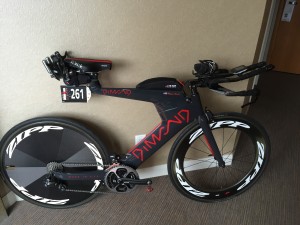 Saturday morning was bike check-in day. They had early bike check in at 9:30 for AWA athletes, so I packed up my bike and run bags and rode the 2 miles to Alta Lake and T1. There weren’t many people there yet as the shuttle busses hadn’t started yet. I racked my bike and covered the aero bars and seat with some plastic bags I had. I really didn’t like the idea of leaving my nice Dimond in the rain all night. Right after I checked in my bike, I got my wetsuit on and swam an easy lap in the lake. The water temp was great.
Saturday morning was bike check-in day. They had early bike check in at 9:30 for AWA athletes, so I packed up my bike and run bags and rode the 2 miles to Alta Lake and T1. There weren’t many people there yet as the shuttle busses hadn’t started yet. I racked my bike and covered the aero bars and seat with some plastic bags I had. I really didn’t like the idea of leaving my nice Dimond in the rain all night. Right after I checked in my bike, I got my wetsuit on and swam an easy lap in the lake. The water temp was great. 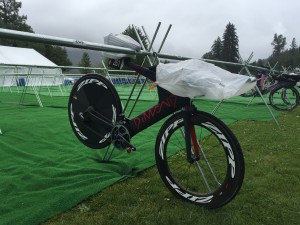 Basically, it felt like swimming in a pool, not too hot and not too cold. There was a bit of chop from the wind which made going out a bit harder than coming back. Overall, it seemed like a great swim venue.
Basically, it felt like swimming in a pool, not too hot and not too cold. There was a bit of chop from the wind which made going out a bit harder than coming back. Overall, it seemed like a great swim venue.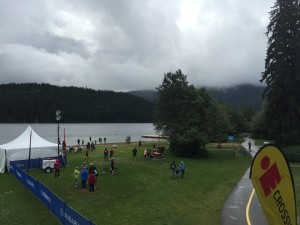
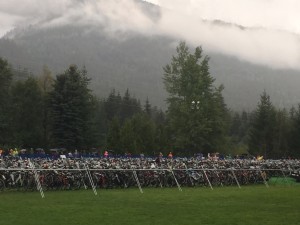
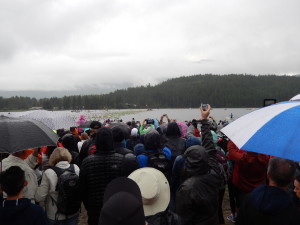

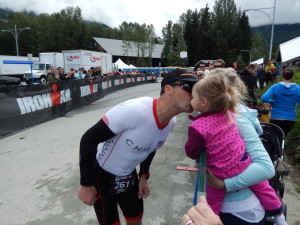 , but this time, my energy was low and my body was already achy. I had to really slow down my pace and I was really worried I’d be walking later in the run based on how I was feeling. Right out of T2, there is a nice climb which really hurts. So right away my heart rate felt like it shot up and my pace dropped back to what felt like a crawl. On the gravel and dirt trails, I wasn’t feeling too great. My stomach started to bother me and I had to walk a small hill because I didn’t have the energy to run it. Due to my stomach being upset, I really wanted to stop and rest to see if I could reset myself, but I kept moving past aid stations without stopping.
, but this time, my energy was low and my body was already achy. I had to really slow down my pace and I was really worried I’d be walking later in the run based on how I was feeling. Right out of T2, there is a nice climb which really hurts. So right away my heart rate felt like it shot up and my pace dropped back to what felt like a crawl. On the gravel and dirt trails, I wasn’t feeling too great. My stomach started to bother me and I had to walk a small hill because I didn’t have the energy to run it. Due to my stomach being upset, I really wanted to stop and rest to see if I could reset myself, but I kept moving past aid stations without stopping.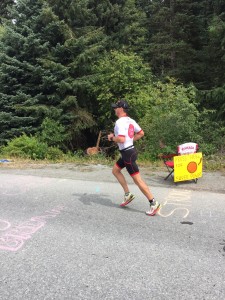
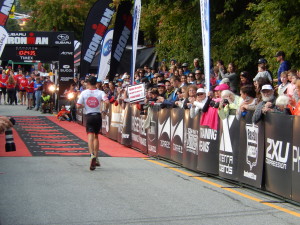
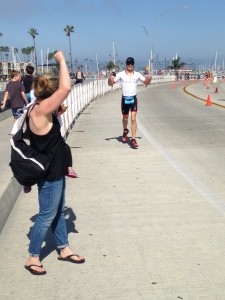
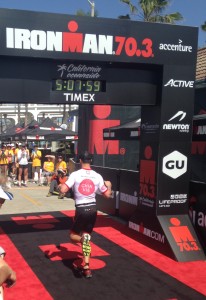 I will say, the crowd support coming in for the finish is amazing. That was the best experience of the whole race.
I will say, the crowd support coming in for the finish is amazing. That was the best experience of the whole race.